Like a signature, each animator has their own little quirks or trademarks that distinguish their animation from others. Some draw character’s features in a unique way (eyes, hands, etc.), some lean heavily on certain principles or include abstract imagery or gimmicks into their scenes, and some fall back on specific poses or gestures. The “Milt Kahl Head Swaggle” is an example of the latter, and it both intrigues and aggravates me at the same time.
To clarify, the “Milt Kahl Head Swaggle” is when a character (animated by Disney legend Milt Kahl) sort of rattles his/her head from side to side, usually at times when they’re feeling cocky or self-assured. Sort of an “Am I great or what?” type of gesture.
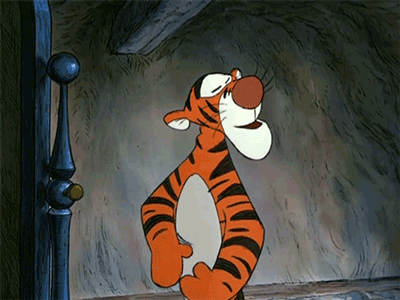
Again, I can’t deny how remarkable an animator Milt Kahl was, but for a long time I considered him to be a really hammy animator in the worst possible sense, and this gesture cemented that idea in me for a good long while.
In a Frank Thomas or Ollie Johnston scene, I could see the wheels turn in the character’s heads and felt that the characters were sincere, emotionally-driven personalities. I never felt that in the majority of Kahl’s characters. A lot of his characters are like actors on a stage, projecting themselves a bit too far in their performances.
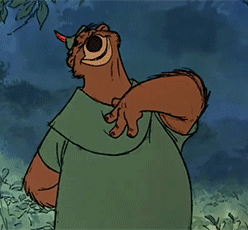
But at the same time, he uses this gesture for a reason, and it works well in every scene he implements it. He only used it on broader, more caricatured characters like Tigger, Sir Ector or Brer Rabbit, characters with strong egos and a cocky sensibility, and the gesture defines the character’s personality in the most simple and direct way possible.

Much like finding an often-reused piece of animation or sound effect in a Disney film, my dislike for it came only from repeated viewings. Because we live in the age of DVDs, Netflix and Quicktime files, we now can have a studio’s entire library literally at our fingertips, able to survey and dissect the content any way we choose, including surveying an animator’s entire forty-year output front to back and taking shots completely out of context like I have here.
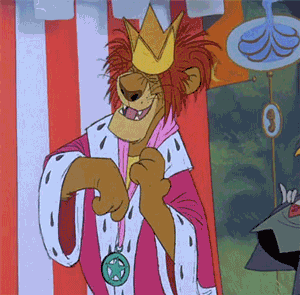
Another thing I realized over time is that Kahl seemed to prefer being a broader animator. For years he was stuck with the most difficult and seemingly less interesting assignments, which the rest of the animators couldn’t pull off because they weren’t as good of a draftsman as him. For example, he clamored to work on characters like Captain Hook but was stuck doing Peter Pan and the Darling children, or with Alice instead of the more zany, off-the wall characters that populate the rest of Alice and Wonderland. He would end up designing a lot of these other characters, but never get to animate most of them.
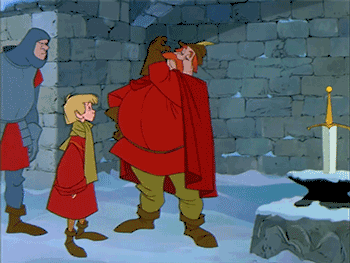
Luckily for him, by the 1960s, Kahl’s creative shackles were loosened and he was back to doing broader animation, and like a free spirit, he went all out on each character, from The Sword in the Stone through The Rescuers. Each character he animated during that period overflowed with energy, all of which was probably pent up inside him for so many years. His days of princes and realistic little children were over, and for the rest of his career he was able to let loose, have fun and do the things he wanted to do.
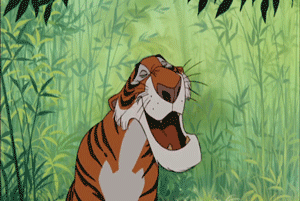
Milt Kahl knew he was a good animator, and he wasn’t afraid to show it through brash flourishes of animation. The head swaggle, corny and over-the-top though it may be, not only defines those Disney characters, but also defines the self-assured Kahl himself.
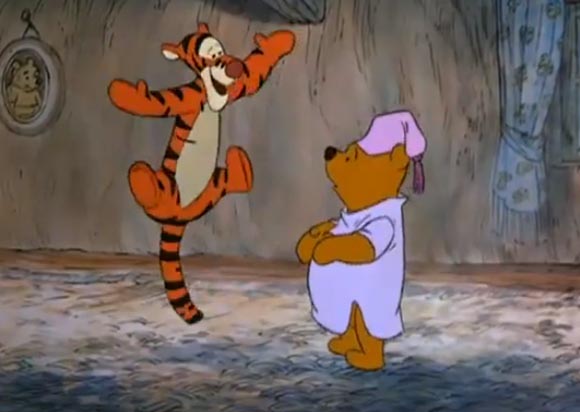
Sometimes when I’m animating, I recharge my creative batteries by watching some of my favorite scenes or pieces of animation. There’s a handful of animated pieces that I watch again and again, but only one that I always return to without fail. It blows me away every time I see it, and upon each viewing, I always seem to discover something new. After every viewing, it makes me strive harder and harder to become a better animator.
No surprise that this scene from Winnie the Pooh and the Blustery Day (1968) is a Milt Kahl scene. I may be one of the very few people who has had the gall to say something remotely negative about Kahl’s animation in the past, but I still think all the admiration for him and his work is completely justified. He could handle anything, and make it look and move beautifully. It’s a shame he wasn’t given more assignments like this one, because I feel that his more cartoon-oriented animation really stands out as some of his best.
While the entire four-minute sequence of Tigger in Pooh’s house is wonderful (great personality animation, dialogue, pacing, etc.), it’s the shot of Tigger bouncing around Pooh that stands out for me. The reason I love that scene so much is that it perfectly encapsulates all twelve principles of animation. In about 7 seconds, each principle is flawlessly showcased, some multiple times, and some intertwining and overlapping one another. As broad and over the top as it is, there’s layer upon layer of intricate elements that make the scene work. It’s a masterpiece of animation, but isn’t brought up too often compared to some of the other characters in Kahl’s career.
For starters, watch when Tigger first begins bouncing: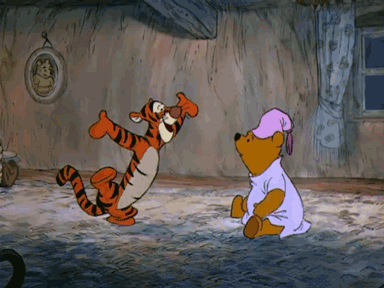
There’s little to no anticipation in his legs, but instead the anticipation is shown in the movement of his head going down before the take off. The tilt of his head, in relation to his arms, legs, ears and whiskers as he first jumps show a great use of arcs. Also notice the successive breaking of the joints on Tigger’s arms, from his shoulders to his elbows to his wrists, and the drag on his fingertips.
As he bounces in place, you can really feel the energy transferring through his body, from his head down to his tail and right back up to his head again, much like a wave action. The folds and wrinkles in his body as he squashes down not only tell us that Tigger is a well-worn toy with loose stuffing, but how much force and weight that Tigger is exerting with each bounce.
Now, Tigger begins to bounce in a circle around Pooh: 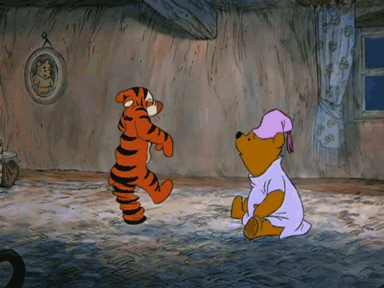
This is why Tigger’s stripes play such an integral role in his design. The stripes sell the idea that Tigger is not a flat drawing, but a three-dimensional living creature. His stripes wrap around the forms of his body and give the illusion of volume. So when Tigger is bouncing around Pooh, those stripes make it clear that Tigger’s body is turning away from us in perspective. Also notice the overlapping action on Tigger’s tail, and how it bends and swings at the kinked parts.
Tigger then jumps up and spins on his tail: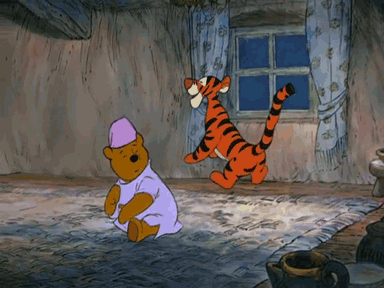
There’s so much going on in this one-second action. Tigger’s torso is twisting and contorting, his top half slightly delayed than his bottom half. Like before, his arms and legs following arcs, and his hands, ears and whiskers are dragging behind. And while all this is going on, he’s squashing and stretching on every bounce until finally easing into his final pose before making physical contact with Pooh and charging offscreen.
And throughout that entire scene, on every bounce, footstep and contact, Tigger is hitting every single beat in the song. Each of Kal’s key poses are appealing, with clear staging and strong silhouettes. Even the animation on Pooh, who takes a back seat in this sequence to contrast Tigger’s outlandish behavior is wonderfully done. It’s almost contradictory how Tigger moves. While he’s galumphing around the screen like a roughhouse, there’s a certain level of grace in his movements. And both Tigger and Pooh’s personalities are easily distinguishable, Tigger being confident and boisterous and Pooh being underplayed and submissive. Overall, a tour de force of animation.
Coincidently, Kahl was also animating Shere Kahn in The Jungle Book around the same time. They’re both tigers (Tigger loosely so), but look how drastically different in approach and execution they are from each other. Shere Kahn is restrained and more subtle—built and functioning like a real tiger, while Tigger is so full of energy and enthusiasm that he’s practically bursting at the seams, and is a completely graphic design. Compare them to Kahl’s caricatured tiger from the Goofy short Tiger Trouble twenty years earlier and you have some sense of how broad Kahl’s abilities were as an animator.
I would’ve loved to know Kahl’s opinion about his own work on Tigger. I know there’s plenty of information floating around about how he felt about Medusa, Shere Kahn, the Brers or any of the human characters he animated, but barely anything about his work on Tigger. If anyone has any insight about this, please share!
For those that want a closer look at this scene, here’s a video of it slowed down 500% with annotations:
 Winnie-the-Pooh will turn 90 years old on August 21st.
Winnie-the-Pooh will turn 90 years old on August 21st.
The New York Public Library will collect birthday cards to celebrate the occasion. Three to twelve-year-old kids can make cards for Pooh Bear and his friends at a special craft event on Tuesday, August 9th.
Everybody can join the party inside the Stephen A. Schwarzman Building on Saturday, August 20th. While you’re there, you can take a peek at an original Winnie-the-Pooh & friends doll set.
continued…
New Career Opportunities Daily: The best jobs in media.













 Winnie-the-Pooh will turn 90 years old on August 21st.
Winnie-the-Pooh will turn 90 years old on August 21st.

Love these shows.